
Stargazing on the Roof of the World, Night Sky Photography Tips in Tibet
The average elevation of Tibet is above 4200 meters. This highest plateau gifts Tibet with thin air, pure sky and dry atmosphere, which are all crucial elements of taking a crystal clear picture of sky. In addition, the giant mountains and tall ridges block most of the clouds out, leaving a clean and transparent night for the stargazers. Tibet is, no doubt, the most perfect gateway from the hustle and bustle to a quiet and indolent night.
Tibet is acknowledged as the nearest place to the universe. When looking at the sky, you just cannot help reaching out your hands to the stars as if you can catch one or two. Shooting the night sky is an indispensable part of a photography tour in Tibet.
Night Sky Photography Sites in Shannan Prefecture
Yamdroktso Lake
Yamdroktso Lake is located at Nangartse County of Shannan Prefecture, some 110 km to the southwest of Lhasa. It is 1 of 3 Holy Lakes in Tibet (the other 2 are Namtso Lake and Lake Manasarovar). The lake is 130 km long from east to west and 70 km broad from north to south. The lake bank is 250 km long and its surface is 638 square km. Standing at an elevation of 4,441 meters above sea level, the lake’s average depth is 20 to 40 meters, with the deepest point at 60 meters. It is the largest inland lake on the northern range of the Himalayas. Supplied with melted ice, the lake has a low level of salinity. In the Tibetan language, “Yamdroktso” is an ancient name meaning “upper pasture”, comparing the lake water to jadeite.
 Yamdroktso Lake
Yamdroktso Lake
It’s hard for modern people to imagine the greatness of Milky Way, because they rarely see one. Even if you escape out of cities, what you can see at night is much inferior than the sky above Yamdroktso Lake. Thanks to the high altitude, the Milky Way that we are looking at is not really a simple ivory-white way. It is actually a colorful river. The stars are red, gold and even blue.
Yumbulagang
A fine, tapering finger of a structure that sprouts from a craggy ridge overlooking the patchwork fields of the Yarlung Tsangpo Valley, Yumbulagang is considered the oldest building in Tibet. Most of what can be seen today dates from 1982. It is still a remarkably impressive sight, with a lovely setting. The founding of Yumbulagang stretches back into legend and myth. The standard line is that it is was built for King Nyentri Tsenpo, a historic figure who had long since blurred into mythology. Legend has him descending from Heaven and being received as a king by the people of the Yarlung Tsangpo Valley. More than 400 Buddhist holy texts are said to have fallen from Heaven at Yumbulagang in the 5th century. Murals at Yumbulagang depict the magical arrival of the texts.
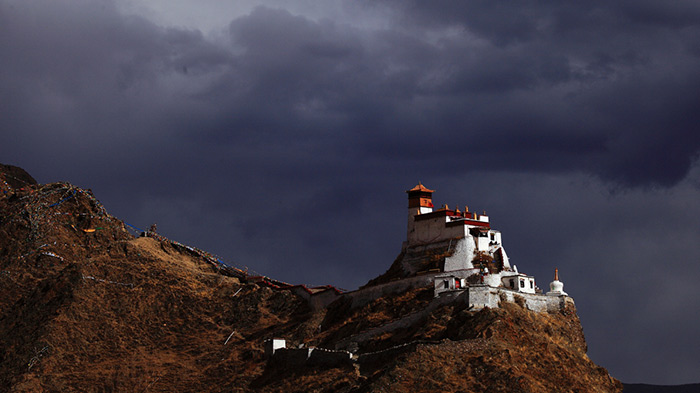 Yumbulagang
Yumbulagang
The best way to show the greatness and holiness of Yumbulagang, is to set the stars and moon as its background. We choose the shooting place and photographing time very carefully. We know when the moon will rise and in which direction it rises. The sky at night is not entirely dark, but a little bit blue with few clouds as decoration. Because of extremely long exposure, you can actually see the track of stars in picture. They are like meteor, setting themselves on fire just to demonstrate the beauty within seconds. However, the moon is so near that you can even see the lunar mare very clearly. The Yumbulagang, under the cloak of darkness, seems more mysterious.
Join-in Most Classic Tibet Photography Tour
Night Sky Photography Sites in Shigatse Prefecture
Everest Base Camp
Everest Base Camp was first used by the 1924 British Everest expedition. The site has a couple of permanent structures and a small army base. Clamber up the small hill festooned with prayer flags for great views of the star attraction, then have your photo taken at the base camp marker, which reads “Mt. Qomolangma Base Camp”. The Chinese indicates that it is 5200 meters above sea level.
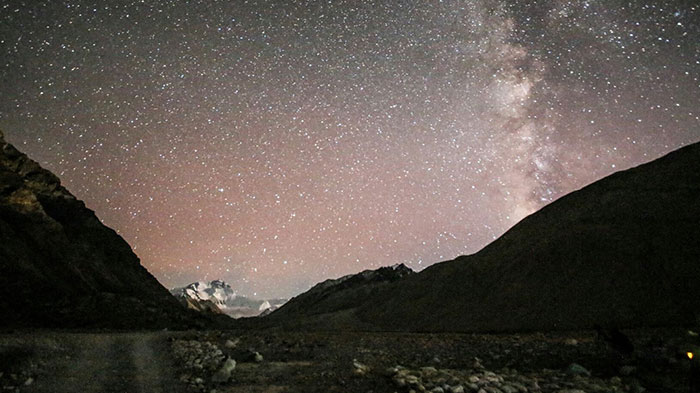 Everest Base Camp
Everest Base Camp
You can see many photos of Mt. Everest whether on the internet or in your friends’ cameras. But the images of Everest standing under the dark night is hard to find. Maybe it’s because Mt. Everest itself is hard to access, or maybe it’s because of the clouds hovering over the peak that block the starry night. Taking a picture of Mt. Everest at night is that hard, but all these reasons make it even more valuable and mysterious. Just image: the highest mountain in the world with ice and snow, the magic flag clouds floating in the sky, the stars falling like rain. What could make a better picture than those? How can you even resist the temptation of taking one by yourself?
Join-in Most Classic Tibet Photography Tour
Night Sky Photography Sites in Ngari Prefecture
Ali Dark Sky Park
Ali Observatory is the best site for stargazing in the Northern Hemisphere. Near the Ali Observatory is an area of 2,500 square kilometers of dark night protection area. Situated at 25 kilometers away from the south of Shiquanhe Town, Dark Sky Park in Ngari, at the altitude of 4,200 meters above the sea level, has Stargazing Experience Area, the Telescope Observation Area and the Passenger Service Area.
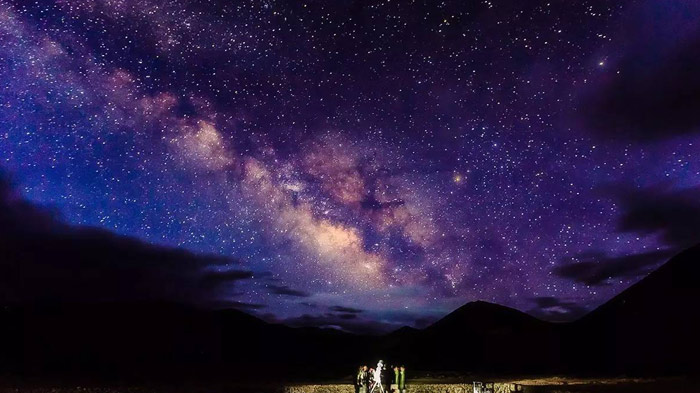 Ali Dark Sky Park
Ali Dark Sky Park
With the support of the Beijing Astronomical Observatory, the park will be equipped with 6 astronomical telescopes. The four refracting telescopes and two reflecting telescopes are the top observational equipment for amateur astronomy enthusiasts.
Lake Manasarovar
Lake Manasarovar is among the world’s highest fresh-water lakes. At an elevation of 4,583 meters, the lake covers 412 square kilometers. With the northern part broader than the southern end, the deepest point of the lake is over 70 meters. The lake is purer than a sapphire and one can see through dozens of meters into the lake. The lake is located in the Burang County, 20 km southeast of the Mount Kailash.
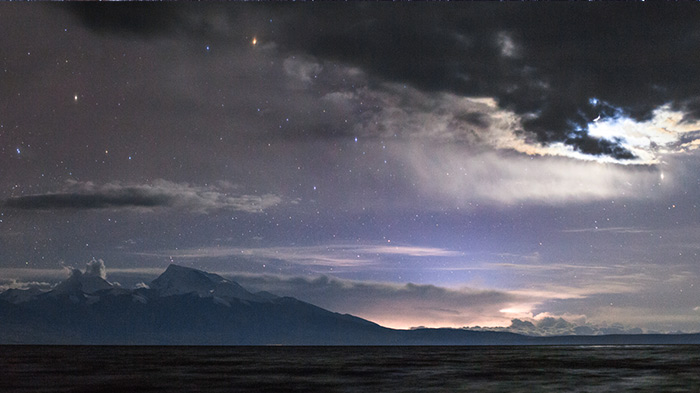 Lake Manasarovar
Lake Manasarovar
When the curtain of night falls down, the moon just rises high in the sky. It lights up the sky but does not overshadow the brilliance of stars. That’s when you should take out your camera and set everything ready, because the perfect moment is short and hard to get. If you miss that, you’ ll have to wait for another day. FYI, staying at Lake Manasarovar in the night could be very cold and freezing. The wind may blow away your camera, your tripod leg and even your car. Only those who ever experienced this unforgettable night, can have the real taste of Lake Manasarovar.
Guge Kingdom
One of the 1st important cultural relic sites under protection, the ruins of Guge Kingdom stand on a 300-meter-tall yellow earth hill on the banks of the Xiangquang River in the Zaborang District, about 18 km away from Zada County. The Xiangquang River runs northwest from the Lake Manasarovar. The river valley is broad with the fertile earth. Rising abruptly from the river bank, the ruins add much mystery to this area.
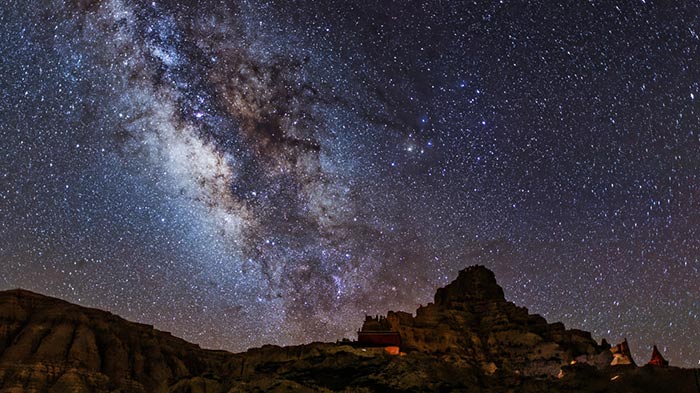 Guge Kingdom
Guge Kingdom
Since the invention of light by Edison in 1879, people have neglect the beauty of stars, especially those who live in cities. When night comes, people light up the sky with various lamps and bulbs. The nightscape that modern people admire, however, will be overshadowed dramatically by that of Guge Kingdom.
The pictures depicting Guge Kingdom at night are extremely rare, because the thought of photographing a night scene of Guge seldom crosses people’s mind. The relics seem even calmer and clearer than ever before during the night. When you look into the sky, you may regard it as a really stable lake with hundreds and thousands of fireflies dancing over the surface. The moon is like a light, protruding the outline of Guge Kingdom just in front of people’s eyes, telling you the stories of this ancient kingdom.
Tholing Monastery
Tholing Monastery is the oldest monastery in Nagri Prefecture. It is situated in Tholing, Zanda County, with altitude of 3,800 meters above sea level. It was built in 997 by Yeshe-O, the 2nd King of the Guge Kingdom. In Tibetan language, Tholing means “hovering in the sky forever”. The complex includes 3 temples, the Yeshe-O Temple, the Lhakhang Karpo and the Dukhang. There are many ancient precious and well preserved frescoes.
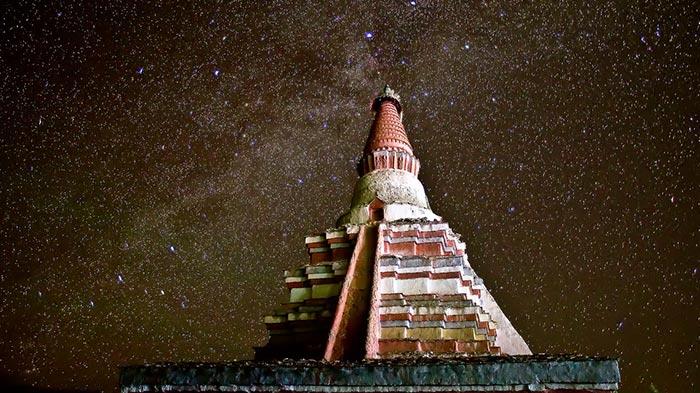 Tholing Monastery
Tholing Monastery
Tholing Monastery standing under the starry night, seems more solemn and more mysterious. You don’t know how, but darkness actually reveals the very essence of the monastery. When moon sprays the light on it, these words just bump into your mind: calmness, holiness and purity. No matter how colorful Tholing Monastery is in daylight, it bows to the vast Milky Way at night. The light of moon and stars is nothing, when the sun is still shining. However in the night, the fragile spark is even more precious and touching.
Join-in Most Classic Tibet Photography Tour
Night Sky Photography Sites in Nagqu Prefecture
Changtang Plateau
The Changtang is a high altitude plateau in western and northern Tibet extending into southeastern Ladakh, with vast highlands and giant lakes. From eastern Ladakh Changtang stretches approximately 1600 km east into Tibet, as far as the province of Qinghai. It is the home of the Changpa nomads. Most of Changtang Plateau is now protected nature reserves consisting of the Changtang Nature Reserve, the 2nd largest nature reserve in the world. Since the reserves have been established, there has been a welcome increase in the numbers of endangered species.
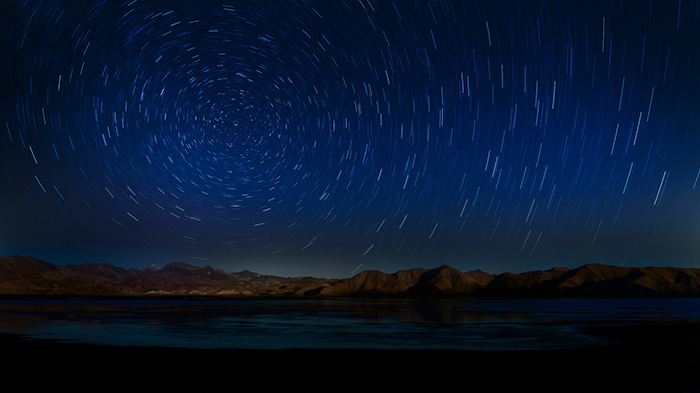 Changtang Plateau
Changtang Plateau
People create cities; cities create nightlife. The nightlife of human beings block the starry night and drives away the clear Milky Way. Without such beautiful and poetic sky, People would be just like birds without wings. Looking up into the starry sky is actually considered as the symbol of wise men. Even the German philosopher Kant once said “Two things fill the mind with ever new and increasing admiration and awe, the more often and steadily we reflect upon them: the starry heavens above me and the moral law within me.” The famous Starry Night by Van Gogh is also considered to be one of the most successful work by people. After all, we human beings are still fans of the sky.
The moon, so big and round, seems reachable when you stand on the Changtang Plateau. Seeing this scene, you may be touched by the pure and quiet moon, which is almost impossible to appear in cities. At night, the moon becomes the “sun”, giving out light, acting as a beacon for all living creatures on the Changtang Plateau.
Namtso Lake
Namtso Lake is the largest lake in Tibet, the 2nd largest saltwater lake in China (the 1st largest is Qinghai Lake), and the world’s highest lake. It is located between the Damxung County of Lhasa and the Bango County of Nagqu region. In the Tibetan language, “Namtso Lake” means “Heavenly Lake”. It along with Lake Manasarovar and Yamdroktso Lake is regarded as the Holy Lake in Tibet. The lake surface is at 4,740 meters above sea level, measuring about 70 kilometers long and 30 kilometers broad, with a surface area of 1,920 square kilometers. Because of the high altitude, you’ll need to acclimatize in and around Lhasa for a few days before heading this way. It is not unusual for visitors to get altitude sickness on an overnight stay out at the lake.
 Namtso Lake
Namtso Lake
Sitting by the Holy Namtso Lake is such a romantic thing. Pilgrims come and go, praying for redemption, luck or happiness to this mirror-like lake, which replies to them with ripples and breeze.
When night falls, the Milky Way is right there. The sapphire sky suddenly turns into a blank canvas, waiting for God to initiate His masterpiece. God sprays the stars randomly and casually. You would never figure out what is going on in His mind, but still, you would definitely love His painting. On the opposite bank, there are some lights on. Maybe, there is someone just like you, sitting on the ground and gazing at the countless sparkles. All that you can see is a bright moon hanging in the sky with numerous twinkling stars; all that you can feel is the wind continuously blowing into your clothes; all that you can think of is nothing except for the phrase: “God Almighty.”
Siling Tso
Siling Tso is the 2nd largest lake (the largest one is Namtso Lake) in Tibet, lying at the south of the Changtang Plateau. In accordance with legend, Siling is an archdevil, who used to live in Duilongdeqing County, west to Lhasa. He greedily devoured thousands of lives every day including both human beings and animals. One day, Padmasambhava found Siling and asked him to stay in the lake forever and confess. From then on, people called the lake “Siling Tso”, which means the “Siling Devil Lake”.
 Siling Tso
Siling Tso
When it’s getting dark, day and night begin to shift their duty. The night is so quiet and calm. The herdsmen begin to light up the lamps in their tents by the lakeside. Everything seems fascinating and tranquil, especially when you gaze at the shining stars. You can feel the inner peace. Siling Tso is lying on the plateau of 4500-meter’s in elevation. With crystal clear visibility, you just don’t know how far your eyes could reach, maybe to the end of the dark night. Suddenly, you realize that, all the stars above your head have stayed there in the sky for like millions of years. Human beings are ultimately so fragile and so negligible when compared with nature.
Join-in Most Classic Tibet Photography Tour
Night Sky Photography Tips in Tibet
1. Remember to bring a tripod that will hold your camera steady.
2. Prepare the related camera accessories, like UV mirror, lens hood, etc. to protect your digital camera.
3. There is no strict standard for camera lens. But it is advised to use wider lens to capture the larger area of vast starry night.
4. It’s necessary to bring a flashlight to see the composition in the viewfinder more clear. It’s also helpful to offer enough illumination.
5. The best time to shoot starry sky in Tibet is the hour before sunrise and the hour after sunset. Remember to avoid the daylight and choose to shoot at clear nights.
6. It’s strongly suggested that you prepare the warm clothes in advance for Tibet's night is really cold and remember not to be frozen.

The Lhasa-born prodigy used to study business overseas, and got his Bachelor of Business in Nepal and India before moving back to his homeland. With pure passion for life and unlimited love for Tibet, Kunga started his guide career as early as 1997.
Responsible, considerate, and humorous, he devoted his entire life to guiding and serving international tourists traveling in Tibet. As a legendary Tibetan travel guru with 20-year pro guide experience. Currently, he is working in Tibet Vista as the Tour Operating Director. Whenever our clients run into trouble, he is your first call and will offer prompt support.


.jpg)



0 Comment ON "Stargazing on the Roof of the World, Night Sky Photography Tips in Tibet"